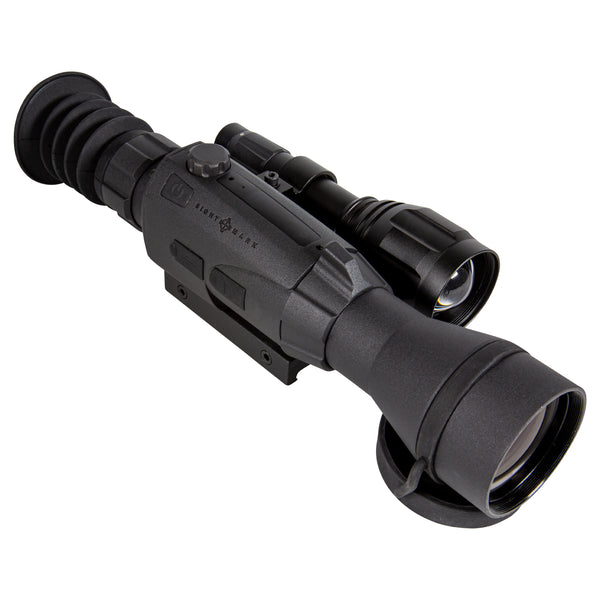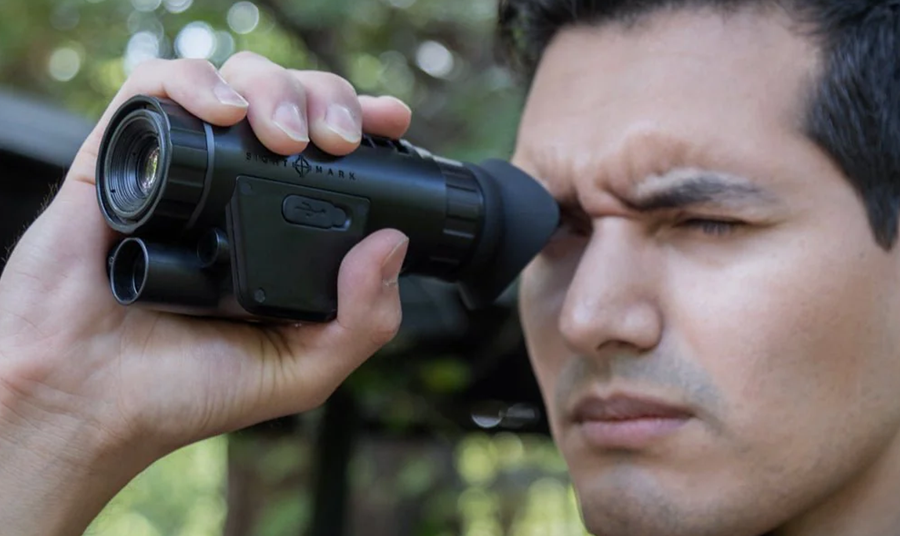Night vision is a technology designed to amplify available ambient light or use infrared illumination to create visible images in low-light or dark conditions. Essentially, it's like viewing the world lit up by an artificial sun that only you can see. Sure, it messes with your depth perception—so walking around can feel a bit clumsy—but that's just the price you pay for playing with light. But how exactly does this wizardry happen? Let's shed some light on the science behind night vision and take a deep dive into its inner workings.
Gen 0 Night Vision: 1939 - Late 1950s
Generation 0 night vision is the grandfather of all night optics, pioneered by the Germans during WWII with their Vampir infrared scope. The Vampir used an IR illuminator mounted on a rifle to project invisible infrared light, converting it into a visible image through a phosphor screen. Although revolutionary for its time, the Vampir scope had significant limitations: it was bulky, heavy, and required a large battery pack that severely restricted mobility. Additionally, its effective range was limited to around 100 yards, and the emitted infrared beam could easily reveal the user's position. The resulting image was grainy, ghostly, and resembled something from an old horror flick.
- Advantages: Cheap (relatively speaking), simple tech.
- Disadvantages: Poor resolution, limited range, and requires IR illumination that can easily give away your position.
- Best Use Case: Backyard adventures and historical reenactments.
- Through-Device View: A grainy, eerie glow with very limited clarity.
Gen 1 Night Vision: 1960s - 1970s
Gen 1 night vision leveled things up by using an image intensifier tube that amplifies existing ambient light—moonlight, starlight, or distant city glow—to produce a clearer image. Early examples like the AN/PVS-2 Starlight Scope saw use by American troops in Vietnam. Soldiers described it as revolutionary but cumbersome, often complaining about its weight and limited field of view. For example, many claimed it was bulky, heavy, and impractical in many terrain situations.
- Advantages: More affordable entry-level option with decent clarity.
- Disadvantages: Image distortion around edges, short battery life, and a noticeable glow from the IR illuminator.
- Best Use Case: Casual wildlife observation, basic night hunting, or fun at night paintball.
- Through-Device View: Dim, green-tinted images with some distortion at the edges.
Gen 2 Night Vision: 1970s - 1990s
Gen 2 devices introduced the microchannel plate (MCP), a technology that multiplies electrons hitting the intensifier tube, significantly improving brightness and sharpness. This generation saw extensive use in military operations, particularly during the Gulf War, where U.S. forces used Gen 2 night vision for reconnaissance and ambush tactics in desert combat. Soldiers noted that while Gen 2 offered a major improvement over previous models, it still struggled in extremely low-light conditions without additional ambient illumination.
- Advantages: Sharper, brighter images, better battery life, and reduced image distortion.
- Disadvantages: Higher cost compared to Gen 1 and occasional blooming (bright areas bleeding into darker ones).
- Best Use Case: Serious hunting, law enforcement surveillance, security applications.
- Through-Device View: Clear, bright visuals with sharper contrast and improved depth perception.
Gen 3 Night Vision: 1990s - Present
Gen 3 night vision is the Ferrari of traditional night vision tech. It utilizes gallium arsenide in the intensifier tube photocathode, dramatically increasing sensitivity to low-light conditions. This is the night vision technology used by modern armies, including the U.S. military and NATO forces. Specific models like the AN/PVS-14 monocular and AN/PVS-31 binoculars are standard issue for infantry and special forces, providing superior night-time operational capability.
One of the most famous uses of Gen 3 night vision was during the raid on Osama bin Laden’s compound in 2011. U.S. Navy SEALs equipped with GPNVG-18s used their night vision to navigate the pitch-dark environment, ensuring a tactical advantage over their opponents. Operators noted that while the technology gave them near-daylight visibility, depth perception was still somewhat impaired, making fast movement and climbing more challenging in total darkness. However, the overwhelming situational awareness provided by these devices proved crucial to mission success.
- Advantages: Excellent low-light performance, long lifespan (up to 10,000 hours), superior clarity and detail.
- Disadvantages: Expensive and export restrictions due to military-grade classification.
- Best Use Case: Professional-grade security, tactical operations, and high-end hunting expeditions.
- Through-Device View: Crisp, detailed images comparable to standard daytime clarity but bathed in a distinctive green hue.
Digital Night Vision: Early 2000s - Present
Digital night vision ditches the intensifier tube altogether, using a sensitive CMOS sensor (like in digital cameras) to capture infrared light. The sensor processes the image digitally, displaying it on a built-in screen—usually in black-and-white or shades of digital green. This makes digital night vision the best choice for civilians, especially those who aren’t comfortable dropping $65,000 on GPNVG-18s—the night vision goggles used by elite counterterrorist operators with essentially unlimited budgets.

Sightmark offers several affordable and high-quality digital night vision options, including the Wraith series of night vision riflescopes and the Wraith monocular, a helmet-mounted solution ideal for hands-free use. Think about it—by saving that money, you could buy an entire other car instead of spending it on high-end military gear! Heck, for the price of a single set of GPNVG-18s, you could buy an entire underground bunker!
- Advantages: Lower cost, day/night usability, no image burn-in, and often includes video-recording capabilities.
- Disadvantages: Requires IR illumination in complete darkness, lower battery life, digital pixelation at extreme distances.
- Best Use Case: Versatile hunting, wildlife watching, security surveillance, and documenting your adventures.
- Through-Device View: Clear, digitalized black-and-white or green images, similar to viewing through a video camera or smartphone display, with occasional pixelation.

Wraith 4K Mini 2-16x32 Digital Riflescope
The Wraith 4K Mini Digital Riflescope combines Sightmark’s rugged quality with advanced digital optic technology, featuring a 4K CMOS sensor and detection range up to 300 yards in low-light conditions.

Wraith 4K Max 3-24x50 Digital Riflescope
Ultra-high-def 4000x3000 CMOS sensor, 3-24x digital magnification, and reliable performance out to 300 yards.

Wraith 4K 4-32x40 Digital Riflescope
Versatile day/night scope with a 4K CMOS sensor, full-color HD imaging, and rugged, user-friendly controls.
Final Thoughts
Now you know how night vision works—from the grainy glow of Gen 0 to the digital versatility of the Wraith series. Whether you're a professional operator, a hunter, or someone who's just curious about the things that go bump in the night, there’s a night vision device for you. If you're after top-tier performance and have deep pockets, Gen 3 is the gold standard. But for the average outdoorsman, digital night vision offers the best bang for your buck—without the price tag of an entire bunker.
Frequently Asked Questions
What is night vision technology and how does it work?
Night vision technology amplifies available ambient light or uses infrared illumination to create visible images in low-light or dark conditions. It essentially allows users to see in the dark by converting light into visible images.
What are the different generations of night vision technology?
There are multiple generations of night vision technology, starting from Gen 0 in the late 1930s to Gen 2 in the 1970s to 1990s. Each generation introduces new advancements to improve brightness, clarity, and performance in low-light conditions.
What are the advantages and disadvantages of Gen 0 night vision?
Advantages of Gen 0 night vision include being relatively cheap and simple technology. However, it has poor resolution, limited range, and requires IR illumination that can easily reveal the user's position.
How does Gen 1 night vision differ from Gen 0?
Gen 1 night vision uses an image intensifier tube to amplify existing ambient light, providing a clearer image compared to Gen 0's use of IR illumination. However, Gen 1 devices still had drawbacks like image distortion around edges and limited battery life.
What advancements were introduced in Gen 2 night vision technology?
Gen 2 night vision introduced the microchannel plate (MCP) technology, which multiplied electrons hitting the intensifier tube to significantly improve brightness and sharpness. This generation saw extensive military use during the Gulf War for reconnaissance and ambush tactics.





1 comment
Love sightmark